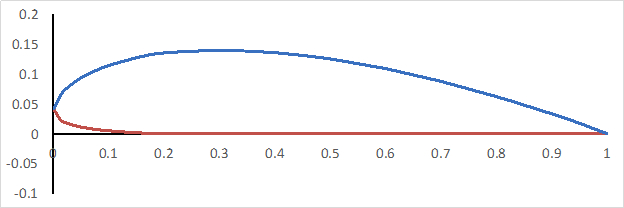Clark Y-14 Wing Performance: Deployment of High-lift Devices (Flaps and Slats)
Source: David Guo, College of Engineering, Technology, and Aeronautics (CETA), Southern New Hampshire University (SNHU), Manchester, New Hampshire
A wing is the major lift-generating apparatus in an airplane. Wing performance can be further enhanced by deploying high-lift devices, such as flaps (at the trailing edge) and slats (at the leading edge) during takeoff or landing.
In this experiment, a wind tunnel is utilized to generate certain airspeeds, and a Clark Y-14 wing with a flap and slat is used to collect and calculate data, such as the lift, drag and pitching moment coefficient. A Clark Y-14 airfoil is shown in Figure 1 and has a thickness of 14% and is flat on the lower surface from 30% of the chord to the back. Here, wind tunnel testing is used to demonstrate how the aerodynamic performance of a Clark Y-14 wing is affected by high-lift devices, such as flaps and slats.

Figure 1. Clark Y-14 airfoil profile.
- For this procedure, use an aerodynamics wind tunnel with a test section of 1 ft x 1 ft and a maximum operating airspeed of 140 mph. The wind tunnel must be equipped with a data acquisition system (able to measure angle of attack, normal force, axial force and pitching moment) and a sting balance.
- Open the test section, and install the wing on the sting balance. Start with clean wing configuration.
- Place a handheld inclinometer on the sting balance, and adjust the pitch angle adjustment knob to set the sting balance
The results of the clean wing configuration are shown in Table 1. Figures 6 - 8 show all three coefficients vs angle of attack, α, for all four configurations. From Figure 6, both the flap and slat enhanced the lift coefficient, but in different ways. Comparing the clean wing and the slat lift curve, the two curves are almost overlapping at low angles of attack. The clean wing lift curve peaks to about 0.9 at 12°, but the slat curve continues to rise to 1. 4 at 18°. This in
Lift generation can be enhanced by the deployment of high-lift devices, such as flaps and slats. Most airplanes are equipped with flaps, and all commercial transport airplanes have both flaps and slats. It is critical to characterize the performance of a wing with flaps and slats during aircraft development.
In this demonstration, a Clark Y-14 wing with a flap and a slat was evaluated in a wind tunnel. The forces and moment measurements were collected to determine the lift, drag and pitching m
- John D. Anderson (2017), Fundamentals of Aerodynamics, 6th Edition, ISBN: 978-1-259-12991-9, McGraw-Hill
Vai a...
Video da questa raccolta:

Now Playing
Clark Y-14 Wing Performance: Deployment of High-lift Devices (Flaps and Slats)
Aeronautical Engineering
13.2K Visualizzazioni

Prestazioni aerodinamiche di un aeromodello: il DC-6B
Aeronautical Engineering
8.1K Visualizzazioni

Caratterizzazione dell'elica: variazioni di passo, diametro e numero di pale sulle prestazioni
Aeronautical Engineering
26.0K Visualizzazioni

Comportamento del profilo alare: distribuzione della pressione su un'ala Clark Y-14
Aeronautical Engineering
20.8K Visualizzazioni

Metodo della sfera di turbolenza: valutazione della qualità del flusso nella galleria del vento
Aeronautical Engineering
8.6K Visualizzazioni

Flusso cilindrico incrociato: misurazione della distribuzione della pressione e stima dei coefficienti di resistenza
Aeronautical Engineering
16.1K Visualizzazioni

Analisi degli ugelli: variazioni del numero di Mach e della pressione lungo un ugello convergente e un ugello convergente-divergente
Aeronautical Engineering
37.7K Visualizzazioni

Schlieren Imaging: una tecnica per visualizzare le caratteristiche del flusso supersonico
Aeronautical Engineering
11.2K Visualizzazioni

Visualizzazione del flusso in un tunnel d'acqua: osservazione del vortice di estremità su un'ala delta
Aeronautical Engineering
7.9K Visualizzazioni

Visualizzazione del flusso di colorante superficiale: un metodo qualitativo per osservare le linee di flusso nel flusso supersonico
Aeronautical Engineering
4.8K Visualizzazioni

Tubo Pitot-statico: un dispositivo per misurare la velocità del flusso d'aria
Aeronautical Engineering
48.5K Visualizzazioni

Anemometria a temperatura costante: uno strumento per studiare il flusso turbolento dello strato limite
Aeronautical Engineering
7.2K Visualizzazioni

Trasduttore di pressione: calibrazione mediante tubo statico Pitot
Aeronautical Engineering
8.4K Visualizzazioni

Controllo di volo in tempo reale: calibrazione del sensore incorporato e acquisizione dati
Aeronautical Engineering
10.0K Visualizzazioni

Aerodinamica multirotore: caratterizzazione della spinta su un esacottero
Aeronautical Engineering
9.0K Visualizzazioni